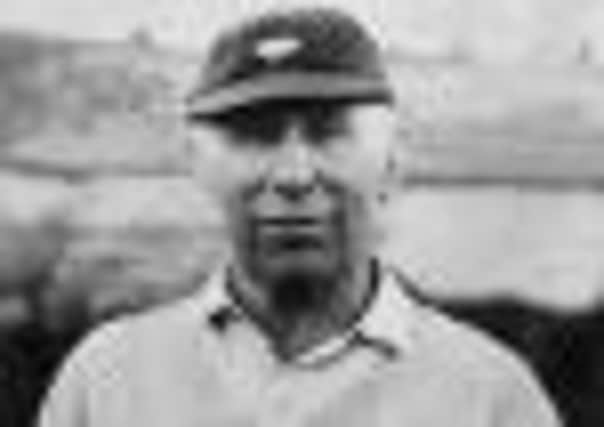Dancing through decades of a real man’s game


WHEN the author first told me he was writing this book, I was somewhat sceptical.
“I’m doing a book on how attitudes towards masculinity have changed during the last century when viewed through the prism of Yorkshire cricket,” said Max Davidson, a regular contributor to the Daily Telegraph.
Advertisement
Hide AdAdvertisement
Hide AdHis plan was to take seven of the county’s greatest cricketers and, in profiling them, to tell the story of evolving manhood.
“I’m going to call it ‘We’ll Get ‘Em in Sequins’,” he added, a play on the famous expression “we’ll get ’em in singles” allegedly uttered by George Hirst to his Yorkshire team-mate Wilfred Rhodes as they set about scoring the 15 runs needed to beat Australia at The Oval in 1902.
Davidson had contacted me to discuss one of his subjects – the former Yorkshire and England fast bowler Fred Trueman.
Trueman, it seemed to him, epitomised the rough-and-ready culture of Yorkshire cricket – a culture far removed from the sequin-clad world of Darren Gough, who appeared on BBC television programme Strictly Come Dancing wearing a variety of lurid costumes.
Advertisement
Hide AdAdvertisement
Hide AdHad Trueman seen Gough hurling himself into the tango and cha-cha, wearing a pair of high-heeled dancing shoes, he would surely have uttered the words, “I don’t know what’s going off out there”.
The contrast between Trueman (the hard-bitten miner’s son) and Gough (the celebrity cricketer with a costume that glittered like a Christmas tree) seemed to encapsulate the author’s remit, but still I wondered if what sounded a good idea in principle might prove something of a contrived undertaking in practice.
Such misgivings were utterly unfounded.
Not only has Davidson made the idea work wonderfully, he has written so well that this is an exceedingly readable book.
Perhaps that is because it is not just a cricket book. As the blurb says, this is also a book with a twist and, thanks to the twinkle-toed Gough, a tango, a samba, and a rumba to boot.
Advertisement
Hide AdAdvertisement
Hide AdDavidson begins by profiling Hirst – Edwardian man personified.
To the cricket-loving Yorkshire public who worshipped him, Hirst represented a platonic ideal of what a man should be.
“Manliness was his birthright,” writes Davidson. “He was virility made flesh. Whether it was the idealised George Hirst of the cigarette cards, with his spotless flannels and burly forearms, or the real-life cricketer, striding out to bat, pacing out his run-up or hurling himself through the air to take a catch, he epitomised the all-purpose man of action: tough, vigorous and combative, without being malicious.”
Next up is Herbert Sutcliffe, the opening batsman of the inter-war period.
Advertisement
Hide AdAdvertisement
Hide AdWith his fluttering flannels and dapper demeanour, Sutcliffe represented a subtle shift in manliness from the world of Hirst.
Says Davidson: “George Hirst always dressed extremely neatly, like most Yorkshiremen, but he was not a dandy; he just faded into the background.
“Sutcliffe set his sartorial sights higher. His fluttering silk shirts – made from consignments of silk from Thailand that he ordered specially for his sports shop in Leeds – were one of the wonders of the sporting age.
“His flannels were immaculate. His buckskin boots gleamed in the sun. He could have been a fashion model.
Advertisement
Hide AdAdvertisement
Hide Ad“Throw in a head of shiny black hair, meticulously parted, and you had the complete package.”
Davidson sees Hedley Verity, the left-arm spin bowler of the 1930s, as the very definition of the strong, silent type - the sort who simply got on with life.
Shy, studious, but with a keen sense of humour, Verity seemed a byword for valour – and indeed died exhibiting the highest of manly callings, that of serving his country in battle.
He was neither flashy as a player nor flamboyant as a person.
Advertisement
Hide AdAdvertisement
Hide Ad“If George Hirst was an all-purpose man of action, and Herbert Sutcliffe was a matinee idol in cricket flannels, Hedley Verity was the boy next door, someone you could depend on,” writes Davidson.
With the arrival of Trueman, manliness changed further.
“Fiery Fred” epitomised a new kind of masculinity – that which took on old-established values and ancient class prejudices.
Whereas the likes of Verity were quiet and subservient, Trueman was loud, brash and immodest.
In an era of ‘Angry Young Men’, he was undoubtedly among the most angry, challenging the conventions of the cricketing establishment in a way his predecessors would never have countenanced.
Advertisement
Hide AdAdvertisement
Hide AdDavidson goes on to profile Geoffrey Boycott, the aforementioned Gough and the sushi-eating Michael Vaughan, bringing up-to-date how attitudes to manliness have changed since Hirst.
He ends by contending it is Hirst who “seems to have been the most rounded human being: the most sane, the most balanced, the most content with his lot, the most uncomplaining, the most easy-going, the most persevering, the most generous to others.
“He had the humanity, as well as the modesty, of the great Edwardians.”
We’ll Get ‘Em in Sequins: Manliness, Yorkshire Cricket and the Century that Changed Everything (Max Davidson, Bloomsbury, £18.99).